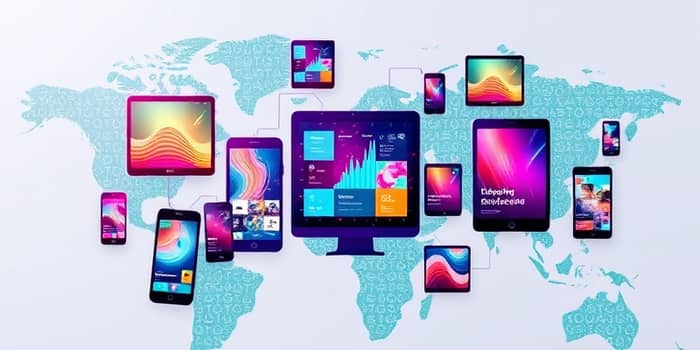
In 2025, marketers stand at the forefront of a digital revolution. Global ad spend has soared beyond US$1.1 trillion, propelled by rapid innovation and changing consumer habits.
The acceleration of internet usage, mobile connectivity, and AI-driven platforms has shifted the balance decisively toward online channels. Brands that adapt will thrive; those that resist risk being left behind.
The explosive growth of online marketing is reshaping budgets and strategies worldwide. In 2024, digital channels commanded 72.7% of global ad investment, a share expected to climb even higher by year-end.
Mobile ads alone represent roughly 70% of digital revenue, underscoring the need for seamless, on-the-go experiences. As consumers spend more time on smartphones and tablets, advertisers must optimize every touchpoint for engagement.
Programmatic platforms now account for 90% of all display purchases, introducing unparalleled efficiency. Real-time bidding engines and automated targeting tools allow brands to deliver messages precisely when and where they resonate.
Video advertising is outperforming traditional formats by over 120% in engagement. Short-form, interactive content captivates viewers, boosting conversion rates by up to 80%.
Platforms like YouTube, Instagram Reels, and TikTok dominate this space. By 2025, video will account for 82% of internet traffic, making it indispensable to any marketing mix.
Brands that invest in short-form, interactive videos boost sales and brand recall. Creative storytelling—tailored to each platform’s unique format—transforms passive viewers into active participants.
With 5G connectivity reaching two billion users, mobile-first tactics are no longer optional. Fast-loading ads, in-app experiences, and geo-targeted campaigns enable hyper-local relevance.
Programmatic advertising accounts for 90% of digital display, delivering ads in milliseconds based on user profiles and context. This level of precision reduces waste and maximizes ROI.
This data illustrates the critical importance of optimizing campaigns for speed, relevance, and automation. As digital channels expand, brands must embrace programmatic tools to remain competitive.
Consumers now expect ads to be relevant and personalized. According to industry surveys, 68% of marketers report that personalized ad experiences significantly improve performance.
AI-driven solutions enable dynamic creative optimization, automatically testing variations of headlines, images, and calls to action to identify top performers. This iterative approach drives continuous improvement.
Investing in real-time bidding and automation platforms empowers teams to reallocate budgets instantly, responding to live data and market shifts without manual intervention.
North America remains the largest ad market, accounting for nearly one-third of global spend. Meanwhile, regions like Africa and the Middle East are posting CAGRs above 16%, fueled by mobile adoption and digital infrastructure investments.
Emerging markets—such as South America and Eastern Europe—offer advertisers untapped potential. However, countries with low digital penetration still lag, highlighting the need for tailored entry strategies.
To navigate this dynamic landscape, marketers need a clear roadmap. Begin by auditing your current digital mix and reallocating budgets toward high-growth channels like video and mobile.
Next, implement programmatic solutions that support campaign optimization in real time. Train teams on AI tools for creative testing, and develop a data-driven culture focused on measurable outcomes.
As digital spend eclipses traditional media, advertising’s role in shaping brand narratives has never been more critical. Effective campaigns not only drive sales but also build lasting loyalty and trust.
By 2029, forecasts predict digital ad investment reaching US$1.4 trillion, reaffirming the value of measurable, scalable strategies. Advertisers who harness innovation, personalization, and regional insights will secure a competitive edge.
Embrace this era of data-driven marketing and creative excellence. The brands that thrive will be those that combine strategic vision with tactical agility, continually adapting to consumer behaviors and technological advances.
References













